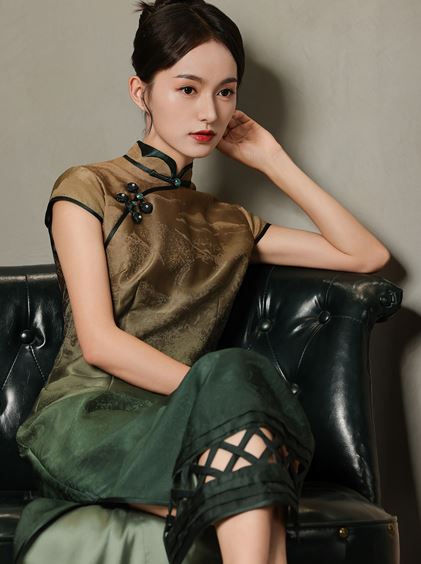Unraveling Qipao: A Modern Guide to this Timeless Chinese Tradition
Introduction
In the vibrant corridors of history, few garments tell a story as rich and multifaceted as the qipao. This elegant Chinese attire, with its origins rooted deep in Chinese tradition, whispers tales of an era where culture and fashion intricately intertwined. The Chinese qipao dress is more than just clothing; it’s a symbol of identity, a canvas of change, and a timeless testament to the beauty and resilience of Chinese heritage. Picture this: the allure of a fitted silhouette emerging from the flapper-inspired fervor of the 1920s, blossoming into a modern emblem of grace and sophistication. As we unravel the fabric of this remarkable dress, we invite you to journey with us through the corridors of time, navigating the seamless blend of tradition and modernity that defines the qipao.
Yet, understanding the qipao dresses are not solely about looking back. The evolution of this traditional Chinese attire reflects broader cultural shifts and global influences, making it a fascinating subject for fashion enthusiasts and cultural historians alike. In today’s rapidly changing fashion landscape, the cheongsam inspired dress stands as a luminous thread connecting past to present—a versatile garment that has been adapted and reinterpreted by contemporary designers across the world. As you delve into this guide, prepare to uncover the layers of significance, discover the nuances of its craftsmanship, and appreciate the qipao’s enduring appeal. Let’s embark on this captivating exploration, where tradition meets innovation, and every stitch tells a story.
The Origins of Cheongsam: Tracing Back Centuries of Tradition
The qipao, also known as the cheongsam, has a history that stretches back centuries. Its origins can be traced to the Manchu people during the Qing Dynasty in China. The Manchus were a minority ethnic group who ruled over China from 1644 to 1912. They had their own traditional clothing, which consisted of loose-fitting robes with wide sleeves and a high collar.
During the Ming Dynasty, which preceded the Qing Dynasty, Chinese women wore a different style of dress called the hanfu. The hanfu was characterized by its loose fit and flowing lines. However, when the Manchus came into power, they imposed their own fashion sensibilities on the Chinese population.
The traditional qipao was born out of this cultural exchange between the Manchus and Han Chinese. It combined elements of both traditional clothing styles to create a new garment that was more form-fitting and elegant. The cheongsam style dress featured a high collar, tight sleeves, and a straight skirt that hugged the body’s curves.
Over time, the traditional cheongsam became increasingly popular among Chinese women from all walks of life. It was not only worn by members of the imperial court but also by ordinary citizens. The dress became synonymous with femininity and grace, representing an idealized image of Chinese beauty.
Evolution of Qipao Dress Through Different Dynasties: Ming, Qing, and Beyond
The qipao underwent significant changes throughout different dynasties in China’s history. During the Ming Dynasty (1368-1644), women wore loose-fitting hanfu dresses made from silk or cotton. These dresses had wide sleeves and flowing lines that emphasized comfort over form-fitting silhouettes.
However, when the Manchus came into power during the Qing Dynasty (1644-1912), they introduced their own style of dress, which eventually evolved into the hinese dress cheongsam. The qipao of the Qing Dynasty featured a high collar, tight sleeves, and a straight skirt that accentuated the body’s curves.
In the early 20th century, as China underwent political and social changes, the silk cheongsam underwent further modifications. Influenced by Western fashion trends, the dress became more streamlined and fitted. The waistline was raised to create a more hourglass figure, and new fabrics such as silk brocade and satin were used to enhance its elegance.
Today, the chinese cheongsam qipao continues to evolve with contemporary fashion trends. Designers are experimenting with different cuts, fabrics, and embellishments to create modern interpretations of this traditional garment. While some designers stay true to its classic form, others incorporate elements from other cultures or add innovative twists to make it more versatile for different occasions.
The Iconic Features of Chinese Dress: Silhouette, Collar, and Fabric
The Chinese traditional dress qipao is known for its distinctive features that make it instantly recognizable. One of its most iconic elements is its silhouette. The dress is designed to fit closely to the body while still allowing for ease of movement. It accentuates the curves of a woman’s figure without being overly revealing.
Another key feature of the cheongsam dress qipao is its high collar. The collar can be either standing or mandarin-style and adds an air of elegance and sophistication to the dress. It frames the face beautifully and elongates the neck.
The choice of fabric is also crucial in creating a stunning modern cheongsam dress. Traditionally made from silk or satin, these luxurious materials drape gracefully over the body and give a soft, lustrous sheen. Today, qipaos can be made from a variety of fabrics, including lace, brocade, and even modern materials like polyester blends.
Whether it’s the form-fitting silhouette, the high collar, or the choice of fabric, each element of the chinese cheongsam qipao contributes to its timeless appeal and enduring popularity.
Traditional Qipao in Modern Fashion: Global Influences and Contemporary Interpretations
The qipao inspired dress has transcended its cultural origins and gained international recognition in the world of fashion. Its unique blend of traditional Chinese aesthetics and modern sensibilities has made it a favorite among designers and fashion enthusiasts worldwide.
In recent years, there has been a resurgence of interest in traditional Chinese clothing. Designers are incorporating qipao-inspired elements into their collections, whether it’s through using traditional fabrics or reinterpreting the dress’s silhouette. The silk qipao has become a symbol of cultural pride and identity for many Chinese people living abroad.
Furthermore, the global fashion industry has embraced the modern cheongsam as a source of inspiration. It has been featured on runways around the world, with designers putting their own spin on this iconic garment. From embellishments to prints to innovative cuts, each interpretation showcases the versatility and adaptability of the qipao in contemporary fashion.
By blending traditional craftsmanship with modern design techniques, these reinterpretations breathe new life into an age-old tradition. They pay homage to the rich history of the qipao style dress while also pushing boundaries and challenging conventions.
Cultural Significance of Modern Qipao: Symbolism and Identity
The qipao holds deep cultural significance for Chinese people. It is more than just a piece of clothing; it is a symbol of tradition, heritage, and identity.
Throughout history, the vintage qipao has been associated with femininity and grace. It represents the idealized image of a Chinese woman, embodying qualities such as elegance, modesty, and poise.
Additionally, the qipao is often worn during special occasions and celebrations. It is a garment that brings people together and reinforces a sense of community and shared cultural heritage.
For many Chinese women, wearing a chinese cheongsam dress is not only an expression of personal style but also a way to connect with their roots. It serves as a reminder of their cultural heritage and acts as a bridge between generations.
Crafting a Traditional Cheongsam: Intricate Techniques and Skilled Artistry
The creation of a chinese dress qipao involves intricate techniques and skilled artistry. From pattern-making to sewing to embroidery, every step requires precision and attention to detail.
Traditionally, cheongsam dresses were handmade by skilled artisans who specialized in different aspects of the craft. The process would start with selecting the fabric and creating a pattern based on the wearer’s measurements. Then, the fabric would be cut into pieces and sewn together using delicate stitches.
One of the most labor-intensive aspects of crafting a qipao cheongsam dress is embroidery. Intricate designs are hand-stitched onto the fabric using silk threads or metallic threads for added embellishment. These embroidered motifs can range from floral patterns to mythical creatures to symbols representing good luck or prosperity.
Today, while some cheongsams are still made using traditional techniques, modern manufacturing methods have also been adopted to meet the demand for this iconic garment. However, there are still artisans who continue to preserve traditional craftsmanship by creating handmade qipaos using age-old techniques.
Unveiling the Influence of Chinese Attire in Pop Culture and Media
The Chinese traditional clothing qipao has made its mark in popular culture and media, becoming an enduring symbol of elegance and sophistication.
In movies, the qipao has been featured in numerous period dramas set in ancient China. Its appearance on the silver screen has helped to popularize the dress and showcase its timeless beauty to a global audience.
Outside of period dramas, the qipao has also been worn by celebrities and fashion icons on red carpets and at high-profile events. Its association with glamour and style has made it a favorite choice for those looking to make a statement.
Furthermore, the traditional qipao dress has become a staple in fashion editorials and photo shoots. It is often used as a symbol of exoticism or as a way to add an element of cultural diversity to fashion spreads.
Through its presence in pop culture and media, the qipao continues to captivate audiences worldwide, showcasing its enduring allure and influence.
Wearing Contemporary Qipao with Confidence: Styling Tips for Different Occasions
Wearing a casual qipao is not just about putting on a dress; it’s about embodying confidence, grace, and poise. Here are some styling tips to help you wear a qipao with confidence for different occasions:
1. Formal Events: For formal events such as weddings or galas, opt for a floor-length cheongsam dress made from luxurious fabrics like silk or brocade. Pair it with statement jewelry and elegant heels to complete the look.
2. Casual Outings: For more casual outings or daytime events, choose a knee-length or midi-length qipao chinese dress in lighter fabrics like cotton or linen. Pair it with flats or sandals for a more relaxed vibe.
3. Modern Twist: Experiment with modern interpretations of the qipao cheongsam by choosing designs with unique cuts or unexpected details. Look for qipaos with asymmetrical hemlines, cut-outs, or interesting sleeve designs.
4. Accessorize Thoughtfully: Choose accessories that complement the qipao without overpowering it. Opt for delicate jewelry, a small clutch, and a pair of heels that match the color palette of your dress.
5. Confidence is Key: Above all, wear your qipao with confidence and pride. Embrace its timeless elegance and let it be a reflection of your personal style and cultural heritage.
Chinese Qipao Dress Beyond Borders: International Recognition and Appreciation
The qipao has transcended its cultural origins and gained international recognition for its beauty and craftsmanship.
In recent years, there has been a growing appreciation for traditional Chinese clothing in the global fashion industry. Designers from around the world have incorporated elements of the qipao into their collections, showcasing its versatility and adaptability.
The dress has also been featured in international exhibitions and museums, further cementing its status as an iconic piece of fashion history.
Furthermore, celebrities and fashion influencers from different cultural backgrounds have embraced the qipao as a symbol of elegance and sophistication. Its timeless appeal transcends borders and speaks to people’s appreciation for beauty and craftsmanship.
Embracing Modern Cheongsam Today: A Timeless Elegance in a Fast-Paced World
In today’s fast-paced world where trends come and go at lightning speed, the traditional chinese qipao dress stands as a testament to timeless elegance.
While fashion may change rapidly, the allure of the formal qipao remains constant. Its form-fitting silhouette, high collar, and luxurious fabrics continue to captivate fashion enthusiasts and cultural connoisseurs alike.
Whether worn for special occasions or incorporated into everyday wear, the qipao allows individuals to embrace their cultural heritage while expressing their personal style.
As we navigate the ever-changing landscape of fashion, let us not forget the beauty and significance of traditional garments like the qipao. By embracing this timeless attire, we honor our past, celebrate our present, and pave the way for a future where tradition and innovation coexist harmoniously.






